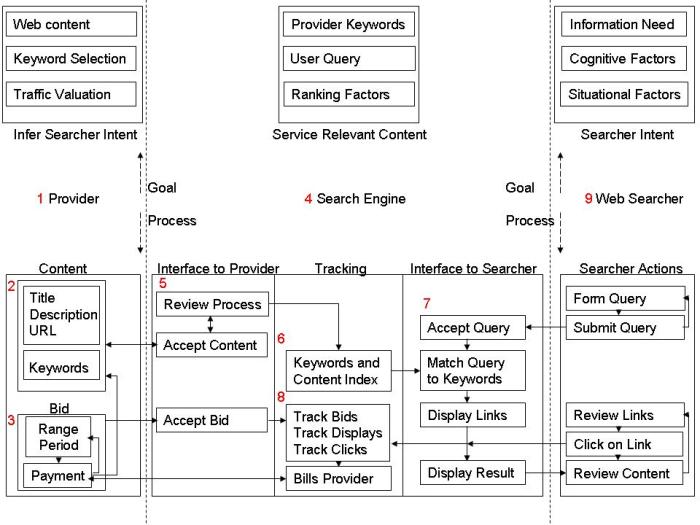Archive for the ‘Overview of Sponsored Search’ Category
The Participants, Goals, and Process of Sponsored Search Process
I am working on the defining the participants and their goals in the process of sponsored search.
The process of sponsored search is continually evolving and gaining complexity as a means of satisfying both Web searchers’ desire for relevant information and content providers’ desire for targeted traffic to their Web sites.
However, although the payment process has undergone several incarnations, the conceptual elements of sponsored search have remained essentially the same.
The major participants and elements that I have identified are:
- Provider: a person or organization interested in generating user traffic to a particular Web site for some specific purpose. We use the term ‘provider’ rather than advertiser to highlight that one can view sponsored search as a version of providing relevant content to a searcher, and not solely an advertising medium.
- Provider Content: a set of keywords (representing concepts) along with the associated uniform resource locators (URLs), titles, and descriptions. Typically, referred to as an advertisement or a sponsored link. Although, these terms have a heavy commercial interpretation, their use has become commonplace within the sponsored search domain. Therefore, we use them in this paper when referring to the provider content displayed on the SERP.
- Provider Bids: bids for specified keywords that are a monetary valuation of traffic to a particular Web site by a provider.
- Search Engine: a search engine that serves the advertisement in response to user queries on SERP, relevant Web sites, or email.
- Search Engine Review Process: a method utilized by a search engine to ensure that provider’s content is relevant to the targeted keyword on contextual material.
- Search Engine Keyword and Content Index: a mechanism that matches provider’s keywords to user queries or to contextual material.
- Search Engine User Interface: an application for displaying provider content as links in rank order to a searcher. Typically, the interface displays the sponsored links with non-sponsored links on a SERP, within email messages, or along side content on a Web page.
- Search Engine Tracking: a means of matching keywords to queries, gathering provider’s content, bids, metering clicks, and charging providers based on searcher clicks on their displayed links.
- Searcher: an agent (i.e., human or automated surrogate) that actually clicks on a sponsored link that is deemed relevant.
